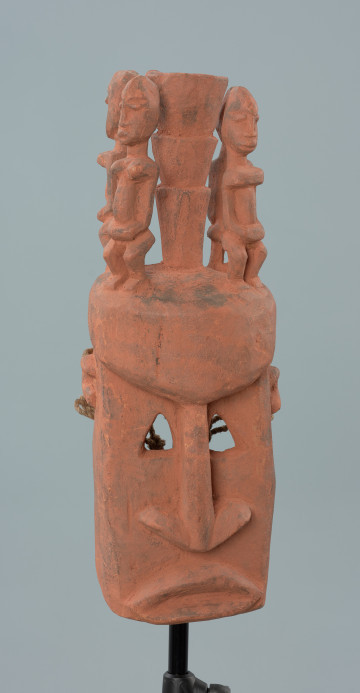
Sirige mask
między 1951 — 1998
National Museum in Szczecin
Part of the collection: Collection of Dogonian art
The sirige mask (in the Sigi-so language - awa danu) symbolises the bunkhouse of a multi-generational family. Like other Dogon masks, it dances during the Dama funeral rituals ending the long period of mourning for the deceased. The masks used during this festival reflect the world known to the Dogon. Among them there are representations of animals living in the bush, images of neighbouring peoples, representatives of the occupations carried out by the Dogon and related caste representatives. Among the masks, one can also see mythical figures and symbolic representations of material objects. According to oral tradition, the masks come from the bush, i.e. a world inhabited by wild animals and other creatures dangerous to ordinary people. Their secret was stolen from the bush by a woman, but in the village where she brought her trophy, it was decided that their power - difficult to tame - was dangerous for women, and so they became the domain of men. Even nowadays, women are not supposed to see the masks, as the sight could be bad for their fertility. Because of their origin, masks represent the outside world, coming from the bush, inhabited by beings endowed with supernatural qualities and knowledge inaccessible to ordinary people. When entering the village, they become the link between the Dogon world and the supernatural world, they also bring wisdom although only a few can perceive and absorb it. The dancers are exclusively men, members of the Awa association, which is part of the cult of the same name. The term awa comes from the secret Sigi-so language and has several meanings. In addition to the association and the cult, it also means a mask that is complete with an entire costume of fibres and the first dead ancestor who turned into a snake.
Ewa Prądzyńska
Author / creator
Dimensions
cały obiekt: height: 400 cm, width: 20,7 cm
Object type
sculpture, mask
Creation time / dating
Creation / finding place
Identification number
Location / status

między 1951 — 1998
National Museum in Szczecin

między 1951 — 2000
National Museum in Szczecin

między 1901 — 1950
National Museum in Szczecin
DISCOVER this TOPIC
Museum of King Jan III's Palace at Wilanów
DISCOVER this PATH
Educational path